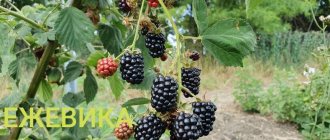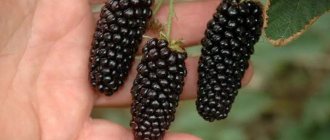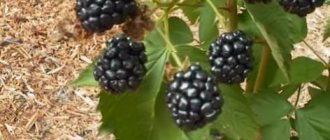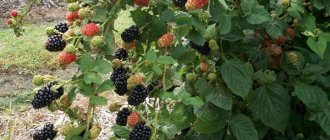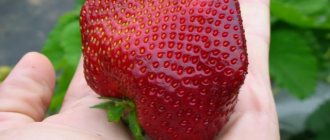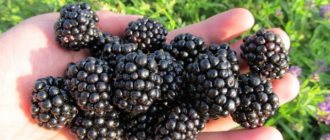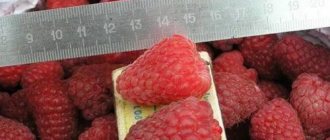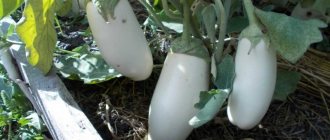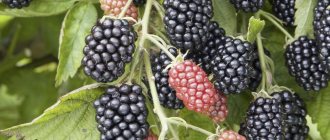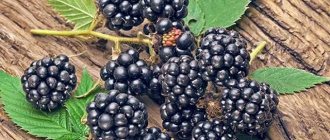History of selection
Garden blackberry Reuben is a late-fruiting variety, bred in the USA under a targeted breeding program and intended for cultivation in the UK and Northern Europe. The program was led by Professor John Reuben Clark, whose name gave the plant its name. The resulting variety is the result of crossing several highly productive blackberry lines from 2005 to 2006. After a number of successful variety trials, Ruben was introduced to the market in 2009. These blackberries began to be imported to Eastern European countries in 2011.
Unlike other representatives of the same group, Ruben bears fruit on shoots of the first year of growth. After fruiting in winter, they are cut to the ground. But if you wish, you can leave it and get 2 harvests. One - at the beginning of the season on shoots of the second year of development, and the second - at the end of the season on new ones.
If we talk about blackberries, there are several types of this plant. Ruben is classified as one of them - kumanika. The main advantage is extreme frost resistance. Its distinctive features:
- compact bush;
- erect shoots;
- very large berries - up to 14 g.
Important! One of the advantages of compact, upright plants is that they can be planted more densely
—
at a distance of 0.5 m, thereby increasing the yield by 1 m
²
.
Subsequent care of the crop
Reuben blackberries need to be cared for carefully, especially in open ground. This is a new variety that has a number of features that need to be taken into account when growing.
Growing principles
Despite the fact that the Ruben blackberry belongs to the brambles - erect varieties with powerful shoots, an adult bush needs a garter. In the first year after planting, the plant can do without a trellis.
In the third year, the Ruben variety comes into full force, its shoots grow to 2-2.5 m and bend under the weight of flowers and berries. It is not good if part of the harvest ends up on the ground. For gartering, you can use any trellis: multi-row, T, E or V-shaped.
Yields are influenced by many factors, from agricultural practices to weather conditions. Good fruiting can be achieved only if all recommendations are followed, which is most easily achieved in closed ground conditions.
In order to speed up fruiting in open ground by 10-14 days, in early spring arcs are installed over the blackberries or simply covered with white agrofibre until the shoots reach half a meter in height.
Necessary activities
The first time after planting, the bush needs to be watered twice a week, spending at least 5 liters of water on each plant. Blackberries are generally a moisture-loving crop, but the Reuben variety is not particularly drought-resistant.
In the spring, immediately after removing the cover, the crop is fed with nitrogen. At the beginning of flowering they provide a complete mineral complex. During the period of berry formation, blackberries are fertilized with a solution of mullein infusions (1:10) or herbs (1:4). In autumn, potassium monophosphate gives good results. Foliar feeding with the addition of chelates is useful for blackberries. In hot weather, the Ruben variety is recommended to be sprayed alternately with epin and zircon every 10-14 days.
Important! Fertilizers containing chlorine are contraindicated for any blackberries.
To increase humidity and retain water in the soil, it is recommended to mulch the soil under the bushes with acidic peat. You need to loosen the soil in spring and autumn. A layer of mulch in the summer will not only increase humidity, but also prevent weeds from germinating.
Shrub pruning
If the Reuben variety is grown as a crop that bears fruit once, all shoots are cut out before wintering. In the spring, new canes will appear, on which the harvest will ripen.
An adult Ruben blackberry bush is formed, leaving 6-7 shoots. You don’t need to pinch them - with sufficient feeding, side branches are already formed in sufficient quantities. Throughout the season, sanitary pruning is carried out - broken, weak or dried sections of the vines are removed.
Preparing for winter
If the Reuben blackberry variety is grown as a once-fruiting crop and all shoots are cut off before winter, it will be enough to place an earthen mound above the root. This is how roses are covered in southern and temperate climates.
In order for the variety to show remontability, before the onset of frost, the shoots are removed from the trellis, last year's ones are cut out, and the current season's growth is tied up, tilted to the ground, and secured. You can arrange a tunnel shelter or use spruce branches, straw, agrofibre and dry soil for insulation.
Comment! The shoots of the Ruben blackberry, although powerful, are flexible, and they have already lost their thorns. This makes the process of covering the bush for the winter at least a little easier.
Botanical description
The height of this deciduous shrub reaches 1–1.5 m. It consists of powerful straight shoots of brown color. Usually blackberries have thorns. Ruben has thorns only on young branches, which is why in some sources such varieties are called thornless. The bush is characterized by great growth vigor and has complex leaves consisting of 3–5 separate leaflets.
Ruben blackberries bloom in late June. Fruiting begins in the first year after planting. The flowers are white, quite large - up to 4 cm in diameter. The harvest begins to ripen at the end of July and lasts until the very end of August. The fruits are black, glossy, with sweet pulp and fruity taste, similar in appearance to raspberries. They can be eaten straight from the plant or used to make jams, pies, juices or sauces.
Description of the variety
The variety is known all over the world. Gardeners are attracted by its excellent yield and large fruit size. The value of the variety is not only in the sweet taste of the berries, but also in its resistance to pathogens of common diseases of berry crops, which greatly facilitates the care of blackberry plantings. But the main feature is remontability, i.e. the ability to produce crops twice per season. Fruiting on two-year-old shoots begins at the end of June. Annual shoots are harvested from September to mid-November.
Characteristic
Description of the characteristics of the Ruben variety:
- This is a remontant blackberry. With it you get 2 harvests per year.
- The berries are homogeneous, dense, with a sweet and sour taste. After ripening, they may begin to crumble.
- Always grows in the form of an upright bush. Prune as needed in October.
- The variety is undemanding to care and not too picky about growing conditions.
- In terms of its needs, it is similar to raspberries. Accordingly, the rules for planting, watering and fertilizing are similar.
- Prefers sunny areas, but growing in partial shade is also allowed.
- The soil for growing should be drained and rich in nutrients.
The berries are characterized by excellent taste characteristics. The average sugar content is up to 11.5% on the Brix scale, acidity is not higher than 8.6%. The aroma is quite intense. Chemical analysis shows that the fruit contains about 140 different compounds of esters and flavonoids.
Video: Blackberry Ruben
Drought resistance, frost resistance
In the wild, blackberries grow all the way to the shores of the Arctic Ocean, so they are quite frost-resistant. But each specific variety has its own requirements in this matter. The Ruben variety was developed for Great Britain. It is included in the 8th and 9th frost resistance zones with a minimum winter temperature of –12°C. And this means that you will not be able to plant it in the Moscow region (5th USDA zone with a minimum temperature of -29°C) and especially in Siberia (1st USDA zone).
The drought resistance of the bushes is at an average level. The bush itself will tolerate drought well, but since the berries are more than 80% water, without moisture you will not be able to get them with a large weight - up to 14 g.
Productivity, fruiting
During the growing season, the plant produces 3.5–6 kg of large berries per bush. Maximum yield is achieved with good watering.
Did you know? Now there are about 370 varieties of blackberries in the world. And most of them were created after 1880. Before this, there was no practice of garden cultivation of this berry.
a brief description of
Advantages of the variety
- Maintainability allows you to significantly simplify agricultural technology.
- The bushes are erect and do not require the construction of trellises or labor-intensive garter operations.
- Large, tasty, marketable berries with good transportability.
- Fruiting is extended - from the beginning of August until the frosts.
- Productivity up to 6 kg. from the bush.
- Simple preparation for winter.
Disadvantages of the variety
- Tolerant to drought - requires watering.
- Insufficient frost resistance for growing in a 2-year cycle.
- Low heat resistance.
Landing Features
Planting is carried out in rows in trenches or holes. It is also possible to install a trellis. This will help in the future care of the bushes.
Landing algorithm:
- Dig a hole larger than the size of the root system. If the plant was purchased in a container, then it must be planted along with the soil. Approximate pit size: 40 x 40 x 40 cm.
- Mix the excavated soil with organic fertilizers.
- Place part of it in the hole.
- Place the bush on top, first straightening the roots.
- Add soil to the hole, compact it and pour in 1-2 buckets of water.
- Repeat watering after 2 days.
Deadlines
Blackberries should be planted in early spring, as soon as the snow melts and the threat of spring frosts has passed. You can continue planting in May. But we must remember that the roots of berry bushes develop better at low temperatures above zero. Also, in early spring, the shrub does not need to devote energy to maintaining vegetation and fruiting.
Did you know? The health benefits of blackberries include improving digestion, strengthening immunity, normalizing heart function, preventing cancer and facilitating weight regulation, maintaining strong bones, and improving vision.
Selecting a location
Before you begin, survey the area and find the ideal growing spot. The plant can grow in full sun or partial shade. But if it is in dense shade, there will be no fruit.
The area needs to be dug up and weeds removed. There should be no dense lumps, stones or sticks in the soil. The soil should be rich in nutrients and well drained. Avoid sandy areas or those where the soil is heavy and clayey. If the soil composition on the site is unsuitable, it can easily be improved by diluting the clay structure with sand or organic fertilizers. Sandy soil can be supplemented with clay when planting.
Do not plant blackberries after peppers, tomatoes, eggplants, potatoes or strawberries. They have the same diseases and pests.
Selection and preparation of planting material
Blackberry bushes are supplied in containers or in plastic packaging. These are plants grown from cuttings. By the time of sale they reach 2 years of age. Each bush will be represented by one straight shoot with a fibrous root system. The top should be shortened. But if this is not done in the nursery, then when planting, shorten the top by 15 cm to stimulate the development of lateral branches.
You may be interested in information about what you can plant blackberries with.
Planting scheme
Blackberries are planted in rows. To make it convenient to care for the bushes and harvest, tie the branches to the trellis. To install it, you will need 2 poles at the edges and one in the middle with a row length of 1 m. Deepen them by 50–70 cm. The height of the poles should be 1–1.5 m above the ground. The trellis also helps improve the lighting of the bush and the circulation of air around it.
Video: How to plant blackberries
Landing
A perennial berry bush can grow and bear fruit in one place for 10…15 years. In order for the plant to delight you with an abundance of delicious berries all this time, you must initially choose the right place for planting.
- The heat resistance of the variety is low, so sunlight exposure should not be maximum; moving shadow or partial shade is acceptable. The bed should be protected from the cold wind by buildings, fences, bushes/trees.
- The best predecessors of blackberries are green manure, cereals, legumes and pumpkin plants. It is not advisable to plant blackberries after berry crops (strawberries, raspberries) - they have common fungal diseases and rot.
- Wet and damp places are not suitable for planting blackberry bushes.
The optimal soil for growing blackberries is breathable sandy loam soil or loam with a neutral or slightly acidic reaction.
To improve the soil composition add:
- in acidic soil - 500 g of lime per 1 sq. m;
- in loam - 1 bucket of sand per 1 sq. m;
- in sandy - 1 bucket of peat or humus per 1 sq. m.
Landing dates
| Southern regions | In autumn - at the end of October, 2-3 weeks before the soil freezes |
| Central region, Ural, Siberia | In spring - in April, before the buds begin to bloom |
Seedlings with a closed root system can be replanted at any time.
What a quality seedling should look like:
- 1 or 2 flexible stems at least 5 mm thick.
- Shiny bark without spots or cracks.
- The root system consists of 2-3 roots of at least 10 cm and additional small roots.
To increase survival rate, before planting, the roots can be treated with heteroauxin or Kornevin according to the instructions.
| Growing method | Optimal distances |
| Separately growing bushes | At least 1.0...1.3 m between plants |
| Rows | At the same planting density, a row spacing of 2.0 m is left. |
Rules for successful planting of blackberry cuttings:
- The area is cleared of weeds and roots in advance.
- The land is fertilized with a nutrient composition: per 1 sq. m contribute 10 kg. compost or humus, 100 g superphosphate, 30 g potassium sulfate or 100 g ash.
- After 2…3 weeks, planting holes 45 cm deep are prepared for the seedlings.
- A mound of fertile soil is placed at the bottom of the pit. A seedling is placed on it and the roots are straightened. As a result, the bush should be buried at 2-3 lower buds.
- The roots are covered with soil to the level of half the depth of the hole. The soil is slightly compacted and well watered - at least 10 liters. for each seedling.
- Fill the hole to the top with dry soil.
After planting, you should mulch the root zone and shorten the seedling to a height of 15-20 cm above ground level. This pruning stimulates the establishment and subsequent growth of side shoots.
Rules of care
The root system of blackberries can live for more than 10 years, but the shoots themselves can only live for 2 years. They immediately grow to a maximum height of 1–1.5 m. The branches will bear fruit at the end of the season. Fruiting occurs in the upper part. And next year the formation of berries will occur in the middle part of the shoot.
Blackberry care will consist of:
- glaze;
- mulching or removing weeds and loosening;
- periodic feeding;
- disease prevention;
- trimmings.
Mulching is necessary to keep the soil moist and loose. This is necessary for the development of the root system. In addition, in the southern regions, mulch protects the soil from overheating. It also prevents the growth of weeds. You can use straw, wood chips, sawdust, pine needles or bark as such. The layer thickness is up to 8 cm. In autumn, the mulch layer is collected and burned. And after the soil completely freezes, they cover it with a new one. This is necessary to protect the roots. In frozen ground they are motionless. But the thaw changes the texture of the soil, pushing the roots to the surface. As a result, they may be broken or damaged by frost. The mulch layer acts as an insulator and prevents this problem.
Important! In winter hardiness zones less than fifth (minimum winter temperature
–
29
°
C) it is recommended to remove branches of any varieties of blackberries from the trellis for the winter and cover them with mulch. In the spring they are raised and reattached to the lattice. In the first year of development, the shrub requires very little fertilizer. And if you added organic matter when planting, then there is no need to supplement it.
Next year, fertilizing is needed to enhance flowering and fruiting. The first is done in early spring at the time the buds open, and the last after harvesting. It is necessary for the formation of next year's buds. About 2.5 kg of fertilizer per year will be needed for every 30 linear meters of row. The composition of the mixture should contain nitrogen, phosphorus and potassium in a percentage ratio of 10:20:10. There is no need to trim shoots in the first year. In the second year of development, you can remove all branches from the previous year or leave them for harvest. But they definitely need to be shortened, since the tops will no longer bloom. This will also stimulate more intense fruiting. In the third year, such shoots will not bear fruit, so they are cut off.
Reproduction
Ruben blackberries belong to varietal plants - in addition to vegetative methods, you can use the seed method to obtain seedlings.
| Methods for obtaining seedlings | The essence of the method | Advantages | Flaws |
| Seminal | After stratification in the refrigerator, washed seeds are planted in a nutrient substrate | You can get an unlimited number of seedlings | The method is too time-consuming. Seedlings will begin to bear fruit only 3-4 years after sowing |
| By layering | In August, the top of the shoot is buried in a hole next to the bush and pinned. Separate from the mother plant the following year in spring. | Simple method, can be planted without damaging the roots at any time | It is necessary to carefully monitor soil moisture |
| Cuttings | In July, green cuttings are cut (about 10 cm each) and rooted in a tree or in separate containers | You can get a large number of seedlings and plant them without damaging the roots at any time | Constant control of substrate humidity. It is advisable to regularly spray the cuttings with water - to create a zone of high humidity. Lower survival rate than when propagated by layering |
Regardless of the method of obtaining seedlings, the varietal characteristics of Ruben blackberries are preserved. And after 3-4 years, each new bush reaches its designed yield. This means that you can enjoy fresh berries and prepare them for the winter - freeze, dry, prepare jam, juices and compotes.
Reproduction methods
Erect, vertically growing bushes are usually propagated using cuttings or young branches separated from the main plant. The length of the cutting is about 8 cm. The thickness is the size of a pencil. They are planted in a container with fertile soil in early spring to a depth of 2 cm. The distance between the cuttings is 6 cm. During the summer they take root and will be ready for planting in a permanent place the next season.
Blackberries also form suckers, as do raspberries. They can be dug up and transplanted to a new location along with part of the root system. Planting is possible at any time, but it is advisable to do it in early spring. When planting in a permanent place, plants are planted at the same depth at which they grew in the container. If the weather is dry and there is no rain, then they need to be watered once every 3 days.
Video: Blackberry propagation
Description of the berry crop
Blackberry Ruben is a promising large-fruited variety. It can be grown not only as a berry crop, but also to decorate the garden.
General idea of the variety
Ruben blackberries belong to the upright varieties, the so-called brambles. Its shoots can reach from 1.6 to 2.5 m in length. The shape of the bush depends on the feeding area and shaping. With dense plantings and vertical garter of vines, the plant will be compact and take up little space. If the distance between the bushes is left greater than 1.3 m, you can grow powerful, beautiful blackberries.
The shoots of the Ruben variety are straight and do not trail. Young growth is green, annual vines with mature wood are light brown. The shoots along their entire length are covered with thorns, which begin to crumble after the berries ripen. This makes it easier to cover for the winter and harvest.
Side shoots grow in sufficient quantity and are easy to shape. The root system is powerful.
Berries
Ruben blackberries form very large flowers - their diameter exceeds 6 cm. The berries are round-cone-shaped, beautiful, about 4.5 cm in diameter, collected in clusters of 8-10 pieces. The weight of the fruit is impressive - up to 14.5 g, the color is black, with a glossy sheen.
The taste of the berries is sweet, with an appropriate slight sourness and a delicate aroma. The fruits are dense but juicy. Tasting score – 4.5 points. But there is no unity in the reviews of gardeners about the blackberry variety Ruben. They consider the taste excellent, others argue that berries cannot be given more than 3.6 points.
This variety is remontant and, under certain conditions, allows you to harvest two harvests per season.
Diseases and pests
Blackberries are not too bothered by diseases. These bushes can get sick if there are diseased raspberry plants nearby on the site. Strong, developed bushes are not afraid of mild forms of disease; they can cope without outside help. But in case of severe infection, it is better to spray.
Diseases can be fungal, viral or bacterial in nature. They enter the bush through damage to plant tissue by pests or mechanical factors. The main treatment for fungal diseases is spraying the bushes with a solution of Bordeaux mixture 1% or copper sulfate 0.5%. Some diseases are activated in wet and cold weather, others in warm weather. There are no effective treatments for diseases of a viral or bacterial nature, so such plants are destroyed.
Did you know? In the UK, it is believed that blackberries should not be picked after Michaelmas Day (October 11), as the devil renders the berries unusable by spitting on them.
Main fungal diseases:
- Anthracnose appears as brown, shapeless spots on the leaves that grow, causing the leaves to dry out and fall off. Occurs in late spring during humid weather.
- Purple spot appears as red spots on trunks and leaves. In places with spots, the shoots crack and as a result dry out.
- A sign of rust is characteristic red or orange spots on the leaves. Appears at the end of spring. Distributes in humid environments.
- Gray rot on fruits manifests itself as a gray coating and soft rotting spots. Harvested berries infected with fungus quickly deteriorate and cannot be stored for long.
Among the ways to combat diseases, it is recommended to plant those varieties that are resistant to them, also to prevent thickening of bushes and remove weeds. Thickets facilitate the spread of insects. Pests are also not often a problem for blackberries. Sucking insects - aphids, thrips - can settle on the lower part of the leaves. Spraying with a soap solution is effective against them.
Main pests:
- The raspberry beetle eats the buds. Having discovered the shedding of the ovaries, spray the bushes with Karbofos.
- The fruit fly Drosophila breeds on ripe fruits. Fitoverm and Actellik are suitable for combating it.
Insecticides used against fruit flies also work well against other insects. If the bushes are well lit and ventilated, this reduces the chance of insect infestation.
Read more about blackberry diseases and pests.
Growing blackberries is not particularly difficult. You just need to take into account that each variety is adapted to a specific climatic zone, and in another zone it may get sick more often and show lower yields. Creating conditions close to optimal for the bushes will help to obtain a high yield.
Disease Prevention
The Ruben variety is genetically immune to many common diseases of berry crops. Only occasionally, in a damp summer, on the lower branches that have been in contact with the ground for a long time, can you notice berries with traces of gray rot. Treatment with 1% Bordeaux mixture before and after flowering will help cope with the disease.
The development of gray rot is promoted by dampness; the disease can affect berries that come into contact with the ground
In dry summers, the shrub may be invaded by aphid colonies. The pest sucks out plant juices, depleting them, which leads to a decrease in yield. Ants spread aphids throughout the area, so first of all you should treat these insects with Anteater and Cypermethrin. Branches covered with aphids are cut off. Spray the bush before and after flowering with Aktara (2 g per 10 l), Aktellik (2 ml per 2 l).
Blackberry shoots affected by aphids are cut off and burned
Planting and care
- Ruben blackberries can reproduce in a variety of ways - by seeds, layering, and dividing the bush. They are all equally effective, but the best option is to buy a ready-made seedling or divide an adult bush. In this case, you will definitely get a harvest in the first year.
- The first thing to do is choose a place. Surprisingly, this berry loves slightly shaded places, and not the sunniest ones. It is better to have tall trees or spreading bushes nearby.
- Groundwater should lie quite deep - at least three meters. If this is not the case, you will definitely have to build a special drainage system.
- In the place where blackberries are planted, there should be no stagnation of water - from excess moisture, the bushes quickly begin to rot, especially young ones.
- Planting should be done in early spring, but the soil should already have warmed up a little. The distance between the holes is at least one and a half centimeters.
- A mixture of humus and soil should be poured onto the bottom; mineral fertilizer complexes can be added.
- After planting, the mound must be mulched.
- Now the blackberries need to be watered regularly, but make sure that there is not too much water. It is most convenient to focus on the soil - if it does not look dry, then it is better to increase watering, and if it is wet, then reduce it.
- After harvesting, be sure to trim the shoots.
What else do you need to know about blackberry reuben?
Blackberry Ruban is a new promising variety that deserves the attention of domestic gardeners. It is still grown little, and there are few reviews about it. Everyone who has ventured to grow this overseas novelty notes that it practically does not get sick and is not damaged by pests.
Also, they note its unpretentiousness and ease of care. According to some reviews, despite the powerful, erect stems, it is still better to tie up Ruben blackberries to avoid spoilage of the berries on the lower branches. Some enthusiasts manage to grow it even in the northern regions, however, the crop is harvested only once, after which the fruit-bearing stems are completely removed at ground level, additionally covering the roots with a layer of fallen leaves, straw or film.
And although blackberries are not yet able to seriously displace the familiar raspberries in our berry gardens, they are slowly taking root in them. And, who knows, maybe our grandchildren and great-grandchildren will enjoy delicious blackberry jam to their heart’s content, and raspberries will be almost an exotic berry crop for them.
Description and characteristics of blackberries
The remontant blackberry Ruben is distinguished by its ability to form large fruits on the shoots of the current year. This plant belongs to the early ripening varieties. The height of its erect shoots is 170-200 centimeters; there is no need for support. The thorns of the Ruben blackberry are small, there are not so many of them, and they do not create any difficulties during harvesting.
The flowering phase of blackberries occurs at the end of June (in the Moscow region). The flowers reach 5 centimeters in diameter and are white in color. The collection of the first fruits begins in early August, the fruiting period lasts until the onset of cold weather. Blackberry productivity indicators are almost 6 kilograms per bush. The weight of the berries is between 10-16 grams, their size is about 4.4 centimeters.
For information! The tasting score for Ruben blackberries out of 5 points is 4.5, and transportability is 4.7 points. .
The fruits are distinguished by their round shape. They are black in color and have a glossy surface. The consistency is quite dense and elastic. The fruitful plant has a high degree of frost resistance, up to -16 degrees. If Ruben blackberries are grown in the Middle Zone, then additional shelter is indispensable.
Fruit characteristics
Reuben blackberries have distinctive berries that are easy to recognize. The berries are large, the average weight of one piece is about 10 grams. The berries are up to four and a half centimeters long. The taste is also very good - blackberries are sweet, with a slight sourness. The drupes fit tightly together.
Ruben is loved by entrepreneurs and not only for his beautiful and appetizing appearance. The fact is that these berries are quite dense and store well - they lie quietly for several days and do not lose quality. They also withstand transportation well.
Features of cultivation
Flowering ends with abundant fruit set in a cool, lingering spring. Frosty winter does not harm the roots and remaining shoots . They are covered with straw, cardboard, and spandex. Blackberries love moisture, but tolerate dry periods without damage. If there is no rain, then once a week you need to water the bush with two buckets of water. It's enough.
All fruit-bearing shoots are cut out at the root in the fall . Ruben is the earliest ripening variety of garden blackberry. She manages to produce powerful shoots, foliage and two harvests of berries. For successful growing season, bushes should be planted in partial shade in a place protected from the wind. The distance between seedlings is at least 100cm .
Flowers develop well and are fertilized in wet weather. 7-8 days before flowering, the roots are watered abundantly , the evaporating moisture creates a comfortable microclimate for the plant. During industrial cultivation, a fine-drip irrigation system is turned on during this period and the bushes are protected from direct sunlight. To ensure abundant harvests in the future, the root system must first be given the opportunity to develop.
The number and size of berries depends on proper and timely soil moisture. You should not overwater the plant, but you should not allow the soil to dry out. Mulching around the trunk plays an important role . Lay straw or grass in a thick layer.
Blackberry Reuben: Pros and Cons
Like any variety, thornless blackberry Ruben has both pros and cons. Having understood them, you can better imagine this berry. An undoubted advantage is that it brings a good, rich harvest, which, with proper care, can be harvested 2 times per season. One bush can produce 5-6 kg of berries. Caring for the bushes is not difficult; the thorns do not cause any inconvenience. A small drawback, or rather inconvenience, is that the second harvest can be harvested in November, and at this time the weather is no longer entirely pleasant, so caring for the bush will not always be convenient. You should also keep in mind that if there were hot and dry conditions in the summer, then the second harvest may simply not appear. Don't immediately get upset and panic.
As you may have noticed, this berry has many advantages, so this is exactly the kind of blackberry that is worth growing on your site.
Harvest and storage
Ruben blackberries are a plant with an early ripening period, so the first harvest can be harvested in late June, and the next one in September-November. The fruits should be picked together with the stalk, but it is better to cut them off so that they can be stored longer. The shelf life of Reuben blackberries at room temperature is 4 days, in the refrigerator - almost 3 weeks.
Ruben blackberries are rightfully considered to be promising varieties. It is unpretentious and produces large berries. It is enough to adhere to the correct agricultural technology to reap a rich harvest.
Care after planting seedlings
Scheme of a garter on a trellis
The plant does not require special care, however, basic agrotechnical measures will have to be carried out. The basic principles of caring for this blackberry: timely watering, loosening the rows, eliminating weeds, fertilizing, pruning, shelter for the winter.
In spring and autumn, this berry perennial is watered twice a month; in summer, during hot, dry seasons, the bushes should be watered abundantly every day. At least 10 liters of water should be added to each bush.
Fertilizing should be done once every 25-30 days. Usually alternate mineral fertilizers containing nitrogen and humus. In summer, it is recommended to apply well-rotted cow manure under each bush.
Blackberry shoots should be pruned annually in the fall. This procedure is carried out in early - mid-November (a couple of weeks before the onset of frost on the soil). The shoots are cut off almost at the root, leaving small knots on the surface (no more than 3-5 cm in height). This procedure allows the plant to winter better and is also a rejuvenating pruning of bushes.
To prevent the plant and fruits from being affected by gray rot, you should not regularly over-moisten the soil in the tree trunks of the bushes.
This shrub is also extremely rarely damaged by pests. The only “harmful” bugs that sometimes attack the foliage and stems of a plant are leaf aphids. These pests are combated as follows: spray the foliage on both sides with a tobacco solution.
